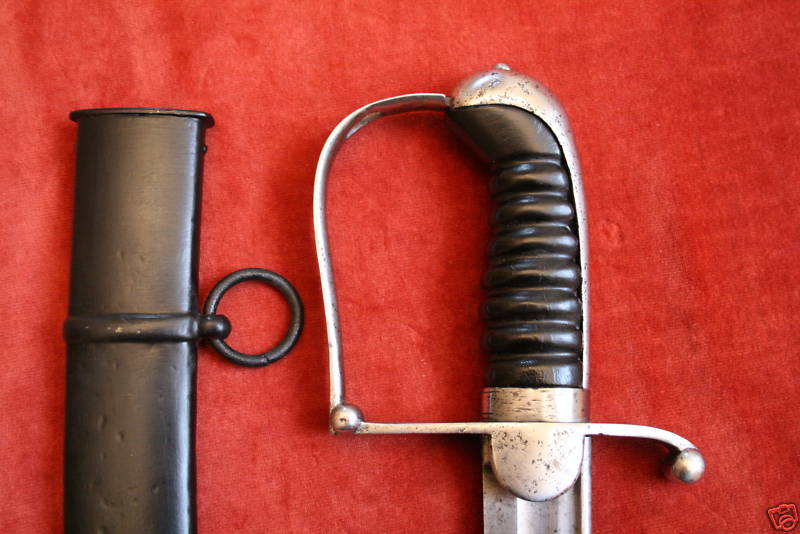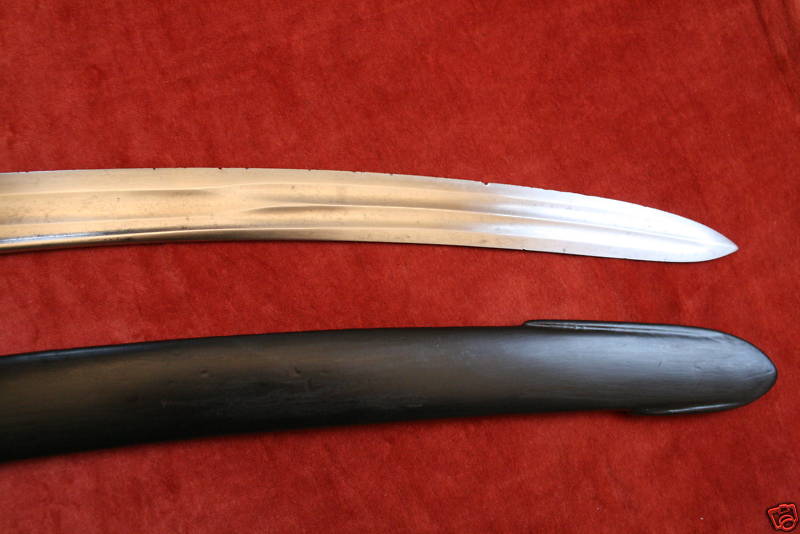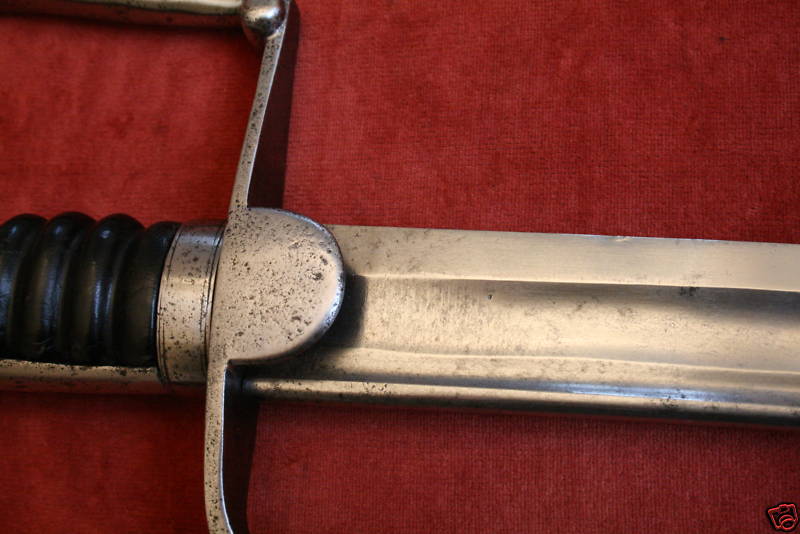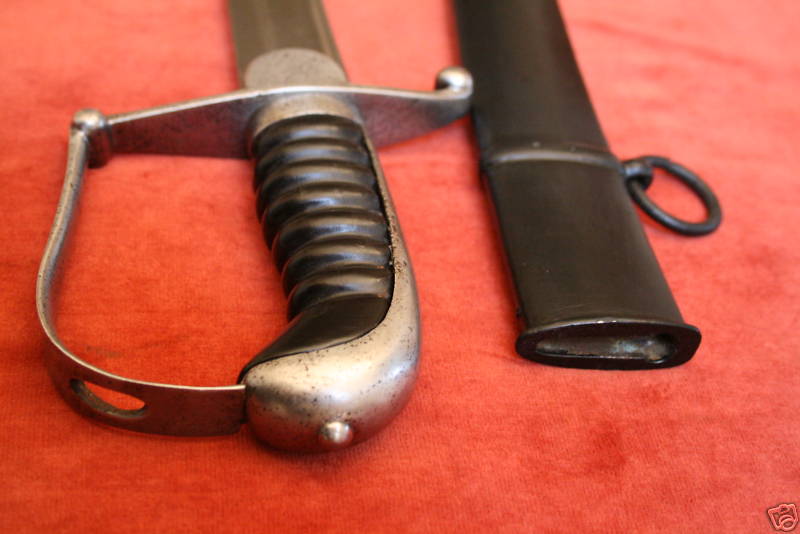| Author |
Message |
Morgan Butler

|
 Posted: Fri 05 Mar, 2010 1:19 pm Post subject: New Sabre Acquistion I.D Posted: Fri 05 Mar, 2010 1:19 pm Post subject: New Sabre Acquistion I.D |
 |
|
I have acquired a new sword, I think it is a private purchase Officer sabre. The blade seems quite fine and is not the usual Birmingham hanger blade. Though like a hangar blade it is only 28 inches. The weight of the whole sword is something over 1.2 pounds. I think it is probably English. I'm curious if it is late 18th or 19th century. It was described as a "British "Georgian" sword, but I wonder if it is too late period to qualify for that term. Still, it looks great! Especially how the blade develops two fullers toward the tip! Anyone have any surmises? Perhaps something more concrete?
 Attachment: 56.68 KB Attachment: 56.68 KB

 Attachment: 23.03 KB Attachment: 23.03 KB

 Attachment: 39.51 KB Attachment: 39.51 KB

 Attachment: 50.03 KB Attachment: 50.03 KB

 Attachment: 42.48 KB Attachment: 42.48 KB

inkothemgard!
|
|
  |
 |
Glen A Cleeton

|
 Posted: Fri 05 Mar, 2010 7:06 pm Post subject: Posted: Fri 05 Mar, 2010 7:06 pm Post subject: |
 |
|
Hi Morgan,
What does the grip seem to be made of? Horn? Wood? Plastics?
The sword seems quite late to me. What (if any) marks are you finding on the blade. My own feeling when looking at,or acquiring swords is to entirely dismiss a seller's description if either one of us cannot pin it to other comparative examples. I honestly have a hunch it is later than ol George the what (fourth?). I think it is all too easy at times to adopt a sellers description without somewhat agreeing. In this case, from what you have shared, I would certainly be looking to a later period. Why on earth would I even think it from Birmingham or even relate it as similar if there is no marking or other possible comparisons at all?
Nice, anyway. the double fuller routine may show up (say, Old Swords) and better place it to time and location.
The Wither's dragon blade baby hussar is what I keep listed in possibles. Good luck with pinning down your current conquest and a browse though Mark Cloakes resources may yield a match.
Cheers
GC
|
|
  |
 |
|
Harry J. Fletcher
|
 Posted: Fri 05 Mar, 2010 9:23 pm Post subject: Just an Educated Guess Posted: Fri 05 Mar, 2010 9:23 pm Post subject: Just an Educated Guess |
 |
|
This looks like a heavy cavalry sabre used by the British during the napoleonic Wars. I just watched watched a two part series on the Smithonian channel and this sword was shown although without the fullers. It caused devastating wounds compared to more narrow, straighter and lighter French Cavalry sabre which the French complained about as causing unnecessary ghastly wounds. After defeating napoleon at Waterloo and concluding this period, the British started using a sabre similar to that the French had used.
Hope this helps.
Harry
To Study The Edge of History
Last edited by Harry J. Fletcher on Sat 06 Mar, 2010 6:59 pm; edited 1 time in total
|
|
  |
 |
Glen A Cleeton

|
 Posted: Fri 05 Mar, 2010 9:54 pm Post subject: Posted: Fri 05 Mar, 2010 9:54 pm Post subject: |
 |
|
Hi Harry,
It is interesting that a basic visual profile can become so ingrained in thought as to associate it with a single example. It is a bit like taking a superficial look at old katana. They all look somewhat similar but when looking past the basic similarity, the variations are endless.
When looking at a sword like Morgan's latest, a good start is looking at what is extremely different when compared to the somewhat ubiquitous British 1796 light cavalry or the 1811 Blucher. Then, looking even a little more closely, immediately seeing no backstrap ears and in this case, a guard and backstrap "pommel" that bears no real similarity to the British 1796 light cavalry swords at all. Add that the blade length is more in line with infantry (or continental artillery, my hunch) and we move even further from what the earlier sword form could really be compared to. Yup, it is a curved sword with a basic profile that lasted more than a century. My gut instinct is that it is more in line with the middle of that time range but I will readily accept earlier or later once a companion example emerges.
I look forward to other thoughts in an ongoing parallel to this thread elsewhere and at the very least, might learn more about this particular sword.
Cheers
GC
|
|
  |
 |
|
Jonathan Hopkins
|
 Posted: Sat 06 Mar, 2010 9:11 am Post subject: Posted: Sat 06 Mar, 2010 9:11 am Post subject: |
 |
|
|
As pointed out in the sister thread at SFI, the scabbard is very British looking and probably dates to the first quarter of the 19th century. I am curious to hear about how well the blade fits the scabbard as it appears to have been made for a pipe back blade. As to the hilt form, it is not that of a typical 1796, but there are numerous variants that are indeed British. I, too, think that based on the length that it would have been used by an officer of dismounted officer. Do you have a copy of Robson, Morgan? There are some hilts depicted therein that are similar (no matches) in form to yours--more basic knuckle guard as opposed to a p-guard. Of course it could be Continental. It is tough to say with the information we have right now. It is a very nice sword and looks like a lot of fun! Congrats on a nice new acquisition!
|
|
  |
 |
Glen A Cleeton

|
 Posted: Sat 06 Mar, 2010 12:44 pm Post subject: Posted: Sat 06 Mar, 2010 12:44 pm Post subject: |
 |
|
Hi Jonathan,
I probably keep an open mind in unidentified examples because of differences I see. I am woefully behind the curve on British examples but some things really kick my butt about this one.
The balled buttress and quliion seem particularly singular and I'd love to find that trait to offer. Why does that strike me as more Latin, or at least later forms?
The blade is another thing to consider and I'm looking at it as more likely not a roll forged blade, which seems to me would be would de riguer of the period suspected and of British work.
I dunno 
GC
|
|
  |
 |
|
Harry J. Fletcher
|
 Posted: Sat 06 Mar, 2010 7:24 pm Post subject: revising my opinion Posted: Sat 06 Mar, 2010 7:24 pm Post subject: revising my opinion |
 |
|
I first stated I thought it was a heavy cavalry sabre but on examination it appears to be a light cavalry sabre of the 1796 type. I also watched the Smithonian program again and did notice that this sabre had a fuller which only extended two thirds of the way down the curved blade.
I located a color picture with detail to examine closely the 1796 sabre. The D shaped langets are shorter and uniformly wide. Also there is a metal extension which runs from the quillon on the top of the handle to the pommel which it overlaps. This strap is secured by ears which partly wrap around the handle in the middle on each side by a rivet which passes thru them and the tang.
The sabre in question does not have some of these features. Also as mentioned by Mr. Cleaton it is too short to be cavalry sabre and so is probably a Foot Officer's sword or Artillery sabre made by Boyle, Gamble, and McFee of Richmond, Virginia The double fuller which is full length yet the simple guard reminds me of similar swords produced for Confederate Officers during the American Civil War. The example I am basing my opinion on has a blade dating to 1820s. Although the blade is nicely done the hilt appears to be a war time job due to its simplicity and materials which is indicative of the civil war period. This is only an educated guess but who knows? Still, it could be a 1796 light sabre blade and the fuller could have been redone and extended with the blade rehilted since it may have had some hierloom or sentimental value.
Regards,
Harry
To Study The Edge of History
Last edited by Harry J. Fletcher on Sat 06 Mar, 2010 8:47 pm; edited 1 time in total
|
|
  |
 |
|
Jonathan Hopkins
|
 Posted: Sat 06 Mar, 2010 8:10 pm Post subject: Re: revising my opinion Posted: Sat 06 Mar, 2010 8:10 pm Post subject: Re: revising my opinion |
 |
|
| Harry J. Fletcher wrote: | | I Also as mentioned by Mr. Cleaton is too short to be cavalry sabre and so is probably a Foot Officer's sword or Artillery sabre made by Boyle, Gamble, and McFee of Richmond, Virginia The double fuller which is full length yet the simple guard reminds me of similar swords produced for Confederate Officers during the American Civil War. The example I am basing my opinion on has a blade dating to 1820s. Although the blade is nicely done the hilt appears to be a war time job due to its simplicity and materials which is indicative of the civil war period. This is only an educated guess but who knows? Still, it could be a 1796 light sabre blade and the fuller could have been redone and extended with the blade rehilted since it may have had some hierloom or sentimental value. |
Harry,
Could you elaborate on this? I don't understand how you are linking this to the ACW and US or CS manufacture.
Thank you,
Jonathan
|
|
  |
 |
|
Harry J. Fletcher
|
 Posted: Sat 06 Mar, 2010 8:43 pm Post subject: Linkage to Confederate Sabre is tenuous but best hope Posted: Sat 06 Mar, 2010 8:43 pm Post subject: Linkage to Confederate Sabre is tenuous but best hope |
 |
|
Well, there is nothing definite except that this sabre does not fit the British example of an 1796 Light Cavalry Sabre. There are only two conclusions (1) it is a fake, (2) it could be a genuine sword but of what manufacture and period? The very fact it was purchased in the United States if it was purchased in the United States would make it somewhat suspect than if it had been purchased in Britain. The sword appears to have been rehilted but not in the Brittish fashion of the period although trying to appear to be from that period. The double fuller makes the sword really suspect and more so than if a single fuller had simply been extended almost to the tip to lighten it. Since I presume it came from the United States it should have military markings such as U.S. stamped on it somewhere and it does not or it would have been noted. It does not have any British markings on or it would have been noted. With no British, American markings or evidence of manufacture the only educated guess one might make is that it was made in time of war, care was given to the blade and no fancy frills given the hilt which points to the Confederacy and their sword makers. The blade could have been imported from Europe during the Confederacy's rush to acquire arms and been hilted. Obviously someone went to a lot of trouble to rehilt this sabre and copy the 1796 light cavalry sabre. Either the Confederate sword makers rehilted the blade and intentionally copied the hilt which manufacturers did in that time since England was a great military power or else the blade of unknown origin was rehilted with the intention of passing it off as as an original 1796 light cavalry sabre. Which do you prefer? Or you could prefer to think that the family had it reworked and somehow it landed in the U.S.
To Study The Edge of History
|
|
  |
 |
Glen A Cleeton

|
 Posted: Sat 06 Mar, 2010 11:48 pm Post subject: Posted: Sat 06 Mar, 2010 11:48 pm Post subject: |
 |
|
Hi Harry,
I apologize if I seem to have led you as far astray as to have you attribute this piece to possibly confederate use or manufacture. Truthfully, that is as likely as offering a reasoning to lead it as far as a trophy of liberation at the Nest of Berchtesgaden in 1945. 
Cheers
GC
|
|
  |
 |
|
Harry J. Fletcher
|
 Posted: Sun 07 Mar, 2010 12:26 pm Post subject: 1945 Liberation Trophy Sounds Good Too Posted: Sun 07 Mar, 2010 12:26 pm Post subject: 1945 Liberation Trophy Sounds Good Too |
 |
|
Hello Glen,
Yes, your explanation for this mysterious sabre sounds as good as my (wild?)conjecture. Do you have any inside information? I would agree that this mystery object is most likely European in origin. And you are right that the avenue of travel to the United States could have been some GI's souvenir from the good war of II coming back with this happy Sad Sack to wind up in this aforesaid country. Truly this is more plausible than my wild as a goose Confederate guess but who knows, the real truth could be even stranger than we both suspect, maybe brought over as a family heirloom by some immigrant from the old country in Northern Europe.
One last observation I might make is that usually a sabre's last third of the blade was left heavier for the slashing /cutting action done by that part of the blade. In the photograph presented by the present owner the fuller(s) extend almost to the tip. Also, the fullers seem to be mismatched starting at the lower third of the blade. Reason? to lighten the blade? or to make the blade more attractive? Can we agree on this last observation?
Regards,
Harry
To Study The Edge of History
Last edited by Harry J. Fletcher on Sun 07 Mar, 2010 2:06 pm; edited 1 time in total
|
|
  |
 |
|
Timo Nieminen
|
 Posted: Sun 07 Mar, 2010 1:07 pm Post subject: Posted: Sun 07 Mar, 2010 1:07 pm Post subject: |
 |
|
| Harry J. Fletcher wrote: |
One last observation I might make is that usually a sabre's last third of the blade was left heavier for the slashing /cutting action done by that part of the blade. |
I would have rather said that usually a sabre's last third was left very thin for the slashing/cutting action done by that part of the blade.
A common complaint about 1796 LC replicas is that this portion is far too thick as compared with originals, and as a result, the sword is overweight and poorly balanced (100g overweight looks typical).
Even on swords like the 1885 and related - hardly cutting-oriented swords - you get a thickness of c. 3mm past the end of the fuller, compared with a spine of over 8mm for most of the length.
The fullers on the tip of this example would mean this likely has a thicker and stiffer tip; a more thrust-oriented sword. This fits with the T-spine.
|
|
   |
 |
|
Harry J. Fletcher
|
 Posted: Sun 07 Mar, 2010 2:02 pm Post subject: Original versus Replicas Posted: Sun 07 Mar, 2010 2:02 pm Post subject: Original versus Replicas |
 |
|
Hello Timo,
Let me say that this appears to be the first time we have disagreed but that being said  , the orginal 1796 LC did not have a fuller for the last third of its blade. Evidence documented by French surgeons during the Napoleonic wars show the effectiveness of the cutting action of the '96 LC although the lethality was not as good as the French sabre it did leave horrific wounds. I have not had the opportunity to handle an orginal LC or a replica to compare them. , the orginal 1796 LC did not have a fuller for the last third of its blade. Evidence documented by French surgeons during the Napoleonic wars show the effectiveness of the cutting action of the '96 LC although the lethality was not as good as the French sabre it did leave horrific wounds. I have not had the opportunity to handle an orginal LC or a replica to compare them.   
Regards,
Harry
To Study The Edge of History
|
|
  |
 |
|
Timo Nieminen
|
 Posted: Sun 07 Mar, 2010 3:19 pm Post subject: Re: Original versus Replicas Posted: Sun 07 Mar, 2010 3:19 pm Post subject: Re: Original versus Replicas |
 |
|
| Harry J. Fletcher wrote: |
Let me say that this appears to be the first time we have disagreed but that being said  , the orginal 1796 LC did not have a fuller for the last third of its blade. Evidence documented by French surgeons during the Napoleonic wars show the effectiveness of the cutting action of the '96 LC although the lethality was not as good as the French sabre it did leave horrific wounds. I have not had the opportunity to handle an orginal LC or a replica to compare them. , the orginal 1796 LC did not have a fuller for the last third of its blade. Evidence documented by French surgeons during the Napoleonic wars show the effectiveness of the cutting action of the '96 LC although the lethality was not as good as the French sabre it did leave horrific wounds. I have not had the opportunity to handle an orginal LC or a replica to compare them.   
|
What do you disagree with? The 1796 is well-known as an effective cutter, also well-known that the fuller terminates well short of the point.
Handle an original if you can. Do compare with replicas if you can. And if you want some hard quantitative data to go with comment on the weight distribution, make sure you measure the thickness of the end portion of the blade.
The facts are simple: the originals were about 850g, and most replicas are more, and have thicker tips. The Cold Steel replica is about 100g overweight, the Weapon Edge replica is over 200g overweight (but this is also blunt, which will add more). The Weapon Edge replica is a little under 4mm thick past the termination of the fuller. Don't be surprised to see closer to 2mm on a real 1796. The fuller doesn't terminate short of the point in order to leave the sword point-heavy, but because the blade thins to the point where a fuller isn't worthwhile.
Originals I've handed are light and agile, handy little cutters. The WE replica is rather more clunky, balancing at 8". Still, it's under 1.1 kg, and not horrible (but maybe my standards are low) even if not close in performance to the real thing.
|
|
   |
 |
Morgan Butler

|
 Posted: Mon 08 Mar, 2010 11:13 am Post subject: Posted: Mon 08 Mar, 2010 11:13 am Post subject: |
 |
|
I have to say I do not think this is in anyway a 1796 LC sabre. I have seen pic of a varient 1796 that was miniturized and shortened for a smaller man. The blade was 32 inches. Mine however is 28 inches. Definately for an officer of foot. I describe it as an evocative mix of a Georgian hilt and a 1796 cav hilt. However it is neither. It is a to my mind a private purchase hanger for an infantry officer. Not only that but I think it is a more expensive, higher quality sword than a few other Birmingham U.K. 18th-19th cent. officer hangers that I own. The blade looks exceptional! Best case scenario it is some kind of British Lt. infantry officer sword from the Napoleonic wars. I am pretty sure the scabbard will fit just fine. The dealer I went thru is reputable to my mind. I have purchased a sword from him before.
I think the whole sword and scabbard was a total custom job! For an officer with some guinea's to his name. I love the 3 fullers! It sort of reminds me of a cinqudea.....I imagine that it will be sharp, light and fast but with the capacity of delivering a good kinetic thwak. I also like how the last portion of the blade goes into a double edged broadsword type tip instead of the usual false edge semi-clipped tip profile.
As Mr. Fletcher noted":
"One last observation I might make is that usually a sabre's last third of the blade was left heavier for the slashing /cutting action done by that part of the blade. In the photograph presented by the present owner the fuller(s) extend almost to the tip. Also, the fullers seem to be mismatched starting at the lower third of the blade. Reason? to lighten the blade? or to make the blade more attractive? Can we agree on this last observation? "
I agree on both those notions! The blade is more attractive and will probably be well balanced because of the two fullers on the end. It will be a fine birthday present to myself.
Glen:
The picture makes the grip appear to be horn or some kind of composite but the dealer said the grip was actually very
nicely preserved leather.
inkothemgard!
|
|
  |
 |
|
Harry J. Fletcher
|
 Posted: Mon 08 Mar, 2010 5:31 pm Post subject: How About This? Posted: Mon 08 Mar, 2010 5:31 pm Post subject: How About This? |
 |
|
This is very, very close and appears to be on the money. It is a Confederate Artillery Offer's sword 28.5 inches long with the same type fuller and stirrup grip made by Starr and based on the 1810 model sabre used thru the civil war.
 Attachment: 58.98 KB Attachment: 58.98 KB
[ Download ]
 Attachment: 58.98 KB Attachment: 58.98 KB
[ Download ]
To Study The Edge of History
|
|
  |
 |
|
|

